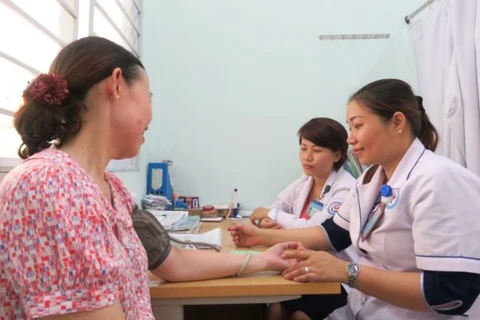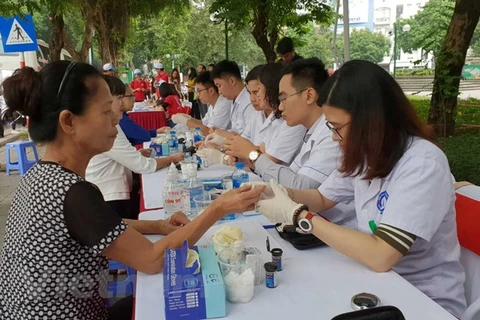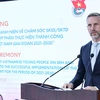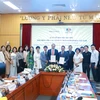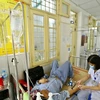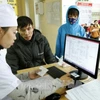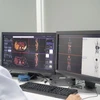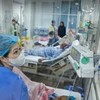Hanoi (VNS/VNA) - Controlling the number of people with hypertension and diabetes is a big challenge for Vietnam, experts said.
As living standards improve, the disease pattern in the country was changing, said Minister of Health Nguyen Thi Kim Tien at a workshop entitled ‘Associate education and treatment in optimising the management of hypertension and diabetes held in Hanoi over the weekend.
Non-communicable diseases account for about 70 percent of total diseases in Vietnam and are the leading cause of death – accounting for 77 percent of total deaths nationwide.
Statistics from the Ministry of Health (MoH) showed that many people were not aware that they suffered from hypertension or diabetes.
The number of patients undergoing treatment was low, with about 29 percent of diabetes patients and 14 percent suffering from hypertension undergoing some form of care. The main reason was a lack of knowledge among Vietnamese patients.
In order to prevent and limit non-communicable diseases including diabetes, the Vietnamese Government has issued the ‘Vietnam Health Programme’ with 11 solutions, Tien said. Of which, four solutions were being actively implemented, including proper nutrition, strengthening physical activity, and preventing harm caused by tobacco and alcohol.
In addition, the MoH was also piloting a programme for early detection of diseases such as diabetes, cardiovascular problems and cancer.
The health sector also focuses on primary health care activities and health promotion associated with grassroots healthcare in communes and districts.
According to the International Diabetes Federation, there were 3.5 million people suffering from diabetes in Vietnam in 2017, and this figure was predicted to rise to over 6 million by 2045.
Given the high rate of diabetics in Vietnam, treatment cost for the disease was a key issue.
Pham Luong Son, Deputy Director General of Vietnam Social Security (VSS), said diabetes was one of the urgent global issues slowing sustainable development, especially in low-income and middle-income countries.
According to the World Health Organisation (WHO), there are now more than 190 million people with diabetes worldwide and this number is increasing.
Every year, the health insurance fund has paid trillions of VND for diagnosis and treatment of diabetes. Given the difficulties in balancing the health insurance fund, it was necessary to manage the expenditure for diabetes examination and treatment properly as this was not only beneficial for patients but also society as a whole.
Speaking at the conference on the management of treatment for diabetes last week, Nguyen Thi Thanh Ha from VSS said tests and diagnosis of diabetes were always among the top 50 technical services with the largest expenditure in Vietnam; accounting for about 8 percent of the health insurance fund’s expenditure.
Last year, the total cost of diabetes treatment was over 5.3 trillion VND (226.7 million USD), up 13 percent compared to 2017.
Participants at the workshop emphasised the need to effectively control expenditure as the cost of treating diabetes was expected to increase by 42 percent from 2017 to 2045.
They said it was essential to strengthen the role of healthcare at the grass-roots level, sharing data from health insurers to limit unnecessary technical services. The application of new techniques and drugs was a must to increase efficiency and reduce costs.
Attention should be paid to information campaigns on non-communicable disease prevention, reducing salt consumption and controlling weight.
It was necessary to strengthen early detection and treatment of the disease; periodically conduct national surveys as part of a non-communicable disease surveillance system to monitor risk factors and implementation measures on prevention of the diseases in Vietnam, they said.-VNS/VNA
As living standards improve, the disease pattern in the country was changing, said Minister of Health Nguyen Thi Kim Tien at a workshop entitled ‘Associate education and treatment in optimising the management of hypertension and diabetes held in Hanoi over the weekend.
Non-communicable diseases account for about 70 percent of total diseases in Vietnam and are the leading cause of death – accounting for 77 percent of total deaths nationwide.
Statistics from the Ministry of Health (MoH) showed that many people were not aware that they suffered from hypertension or diabetes.
The number of patients undergoing treatment was low, with about 29 percent of diabetes patients and 14 percent suffering from hypertension undergoing some form of care. The main reason was a lack of knowledge among Vietnamese patients.
In order to prevent and limit non-communicable diseases including diabetes, the Vietnamese Government has issued the ‘Vietnam Health Programme’ with 11 solutions, Tien said. Of which, four solutions were being actively implemented, including proper nutrition, strengthening physical activity, and preventing harm caused by tobacco and alcohol.
In addition, the MoH was also piloting a programme for early detection of diseases such as diabetes, cardiovascular problems and cancer.
The health sector also focuses on primary health care activities and health promotion associated with grassroots healthcare in communes and districts.
According to the International Diabetes Federation, there were 3.5 million people suffering from diabetes in Vietnam in 2017, and this figure was predicted to rise to over 6 million by 2045.
Given the high rate of diabetics in Vietnam, treatment cost for the disease was a key issue.
Pham Luong Son, Deputy Director General of Vietnam Social Security (VSS), said diabetes was one of the urgent global issues slowing sustainable development, especially in low-income and middle-income countries.
According to the World Health Organisation (WHO), there are now more than 190 million people with diabetes worldwide and this number is increasing.
Every year, the health insurance fund has paid trillions of VND for diagnosis and treatment of diabetes. Given the difficulties in balancing the health insurance fund, it was necessary to manage the expenditure for diabetes examination and treatment properly as this was not only beneficial for patients but also society as a whole.
Speaking at the conference on the management of treatment for diabetes last week, Nguyen Thi Thanh Ha from VSS said tests and diagnosis of diabetes were always among the top 50 technical services with the largest expenditure in Vietnam; accounting for about 8 percent of the health insurance fund’s expenditure.
Last year, the total cost of diabetes treatment was over 5.3 trillion VND (226.7 million USD), up 13 percent compared to 2017.
Participants at the workshop emphasised the need to effectively control expenditure as the cost of treating diabetes was expected to increase by 42 percent from 2017 to 2045.
They said it was essential to strengthen the role of healthcare at the grass-roots level, sharing data from health insurers to limit unnecessary technical services. The application of new techniques and drugs was a must to increase efficiency and reduce costs.
Attention should be paid to information campaigns on non-communicable disease prevention, reducing salt consumption and controlling weight.
It was necessary to strengthen early detection and treatment of the disease; periodically conduct national surveys as part of a non-communicable disease surveillance system to monitor risk factors and implementation measures on prevention of the diseases in Vietnam, they said.-VNS/VNA
VNA


